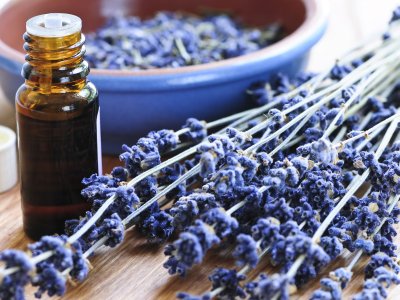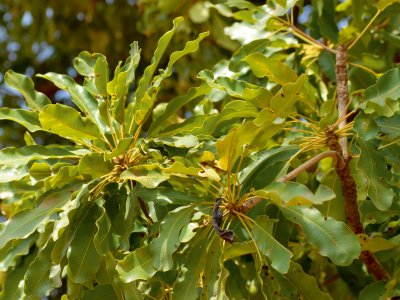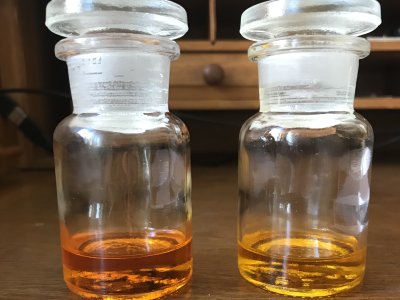Medical Aromatherapy

Medical Aromatherapy
by Kurt Schnaubelt.
1999 edition
Reviewed by Martin Watt.
I had high hopes for this book as it was only published in 1999 years after other aromatherapy books. It therefore had a chance to correct errors made by previous authors. Sadly I was disappointed as it contains the same old recopied errors on the therapeutic uses of essential oils.
Page vii First paragraph: "the fact that aromatherapy is also a healing tool and a form of communicating with plants".The “form of communicating with plants” looks like it is designed to appeal to 'new-age' sheep. I think that a living plant would be very upset at the thought of its relatives being cooked alive during distillation!
Page 2 - first paragraph: Here he claims that “it is difficult to quantify the effects of aromatherapy”, and that “scientists are uncomfortable around the subject of aroma and emotion”. This claim is astonishing from someone who claims to have a University degree. There have been hundreds of studies on the effects of fragrance and how they affect the brain and how that in turn affects emotions. This includes brain scans to see how brain centres are affected. Therefore the statements are incorrect.
Page 4: He talks about the book 'The Practice of Aromatherapy' by Valnet as if it was a landmark in aromatherapy. In reality it is mainly a book about herbal medicine. The author frequently fails to differentiate sufficiently between the use of the herb and the use of the essential oil. That has been responsible for major blunders on the therapeutic uses of essential oils by subsequent authors and teachers. Therefore I do not see this book as a valuable landmark.
Page 21 - last paragraph: He talks about the widespread use of Basil as a cure-all, but fails to mention that it is the herb and not the essential oil. To even hint that the oil may be effective against the Polio virus is in my view dangerous and no reference is given. I have seen this outrageous claim made on aromatherapy suppliers web sites particularly in Canada.
Page 33-34: The medicinal claims in these charts for the different type of Basil are preposterous, incorrect and dangerous. Many of the stated conditions could never be treated via the external use of these oils. The conditions are based on the error ridden chemical concepts of a couple of teachers from France. They knew next to nothing about essential oils and so they invented the therapeutic uses.
Page 37: The medicinal activities of these broad chemical groups are one of the worst, if not the worst, misleading chemistry to be found in aromatherapy education. For example, to claim that any oil high in aldehydes will have an "antinflammative effect" is dangerous. An essential oil high in aldehydes such as E. citriodora is mild on the skin. On the other hand, another oil such as cinnamon bark will burn the skin. Therefore to make such sweeping generalisations of activity based on such simple chemistry is incorrect and dangerous. See:
http://phytovolatilome.com/essential-oil-chemistry-functional-groups/
Page 42 - second paragraph: "almost every single medicine that promises relief actually offers dependence and horrific side effects". Not only is this statement incorrect it is unnecessarily alarmist. As with much in these introductory paragraphs, there is a lot of unsound philosophising without proper backup.
Page 55: An anecdotal case is quoted without a checkable reference. In the references section at the end of the book, you cannot tell which reference applies to which statement. It looks to me like this case was one published in an aromatherapy journal where no attempt to verify its authenticity would have been made. Therefore, it is not known what may have caused the patients reaction to Khella oil.
Page 174: "Citrus and needle oils claimed to be an irritant over time due to peroxidation". This is an indication of an author who does not know the difference between irritation and sensitisation. In reality, these oils form sensitising agents over time with exposure to air. Sensitisation can be a serious condition and therefore should not be taken as lightly as irritation.
"Juniper may irritate and/or damage kidney tissue". Yes of course if you drink enough of it, but is that what this book is about?
The same old tired nonsense about 'oils high in ketones being neuro and hepato-toxic'. I would guess this has been extracted from the course notes or book from the French aromatherapists. These oil can be no more dangerous than other oils that may be low in ketones. It all depends on how they are used and how much. This kind of simplistic chemistry has become an unstoppable cancer in aromatherapy. It is regrettable that a supposed science graduate (like this author claims to be) still promotes pseudo-science.
Page 177-192: The chemical classifications are highly misleading and wrong. They are partly from the book by Penoel and Franchomme which had to be completed by editors and is therefore packed with major errors. The unverified assumptions of the action of essential oils are based on the individual chemicals that it contains. See:
http://phytovolatilome.com/essential-oil-chemistry-functional-groups
Page 178: A chart which is also pseudo-science originating from the same French authors referred to above. Even if some of the properties of the individual chemicals may be correct, they cannot possibly form an accurate guide to the properties of a whole essential oil containing hundreds of chemicals all with different actions.
Page 207 - Vitex agnus castus oil: No references are provided on where the idea originated that oil of Agnus castus may have the same effects as are observed for the herbal preparation. Almost all the claims made for this oil are drawn from herbal practitioners who never used the essential oil. To suggest using this oil as internal medication - as suggested here - without any evidence as to its safety is outrageous, particularly in view of its possible effects on the female reproductive system. In addition, it is known that certain suppliers sell the oil extracted from vitex leaves, a part of the tree that was not used in traditional medicine. The reason for that is because the leaf oil is cheaper than the pure berry oil. In my opinion, a dangerous and unscrupulous practice toying with the health of their clients based on no evidence of efficacy or safety.
Page 208 - Spikenard oil: Recommended for internal use, yet that was not used in the traditional medicine of the part of the world that it comes from. The main use for this oil has always been in perfumes and allied fragrances. The Author even acknowledges that some sources of the oil are "dubious"and yet still places it in his preferred mode of use section.
Page 208 - Vetiver: A mention of "controlled experiments" yet no mention of the reference to that work. Was it internal or external use, oil or herb? Surely the reader is entitled to that information in view of the suggested therapeutic uses and the title of the book.
Page 209 - Helichrysum oil: As before, significant therapeutic claims such as "regulates cholesterol and stimulates liver cells" with no reference to substantiate the claims. Recommended for internal use, yet that was not used in the traditional medicine of the part of the world it comes from.
Page 211 - Cypress: Outrageous claims such as useful for "whooping cough; tuberculosis; pleurisy" - all conditions that are serious if not illegal for anyone other than a doctor to treat. All drawn from the awful book by Franchomme and Penoel. Many of the uses are traditional ones of a water based herbal preparation containing substance such as astringent tannins that are not found in the essential oil at all.
Page 211 - St johnswort: Suggested for "kidney infections" a serious and possibly life threatening condition which should only be treated by a doctor unless one is living 500 miles from the nearest one! There is no known safety data for this essential oil and the plant and infused oil are known photosensitizers.
Page 213 - Anise seed oil: "It has an estrogen-mimicking effect and can be used to treat amenorrhea". This action is far from being confirmed in humans for the essential oil. In view of the fact it is a common permitted food flavour, I believe such an action is unlikely. For the whole seed consumed as a medicine maybe, but as previously, a typical confusion of traditional uses of the herb with the oil. Also, there are many reasons for amenorrhea which cannot be treated just by a single oil. Some of them can be serious medical and/or psychological conditions.
Page 213 - Cinnamon bark oil: A list of its antimicrobial activity much of which is justified. However, the same can be said of sulphuric acid and who would want to consume that as is suggested here? Cinnamon bark oil is a powerful skin and mucus membrane destroyer. In the mouth it will destroy mucus membrane cells and leave raw patches. In the gut it will do the same unless it is diluted appropriately and is used in buffering agents. On the skin it is a known sensitising agent. Certainly not an oil to be played with.
Chapter 12 Applications. At risk of boring the reader of this, I can't comment on everything that is wrong is this section, but will make some general comments.
Page 223 Beware ofthe internal uses section. Much of this is based on the work of a French doctor who works only in private practice, does not publish research papers and has never had his outlandish methods peer reviewed.
Beware anything on internal uses. Adulteration of oils in aromatherapy is endemic, therefore you are playing with fire unless you personally know growers and distillers.
Pages 232 -236:
Conjunctivitis.Never use anything in the eye unless you know the hydrosol or similar product is free of micro organisms. Most small suppliers in aromatherapy do not have a clue on the contamination of hydrosols that they sell.
Fever. This is quack medicine. No essential oils have the ability to reduce a high fever.
Lymphatic support. Quack medicine. Essential oils do not penetrate the skin in sufficient volume to get into lymphatics, therefore they cannot possibly affect them.
Digestive tract. This can only be affected via internal use of essential oils with the inherent risks already mentioned. Particularly beware of Rosemary verbenone type, this can be and is manufactured using synthetic verbenone added to normal rosemary oil. There is no safety data available on the real oil.
There are many serious medical conditions mentioned in this section. Many of them should only be treated by a qualified doctor, several of them are proscribed infectious diseases which must be notified to the respective authorities, and several of them require an in depth medical training to diagnose and treat them. An aromatherapist or even a nurse aromatherapist, should never attempt to treat such conditions unless all else has failed.
Beware of the chart on page 237. Dangerous, wrong and highly misleading.
SUMMARY.
In my opinion, this book masquerade as an authoritative text on the medicinal uses of aromatherapy. It was designed more to raise the profile of the author, rather than act as a valuable contribution to the practice of aromatherapy. This is just one more of similar books packed with information based on inaccurate, simplistic and hypothetical chemistry. Much of the therapeutic uses information confuses the internal use of herbal medicine with the external use of essential oils. In addition, this book contains information that is very dangerous if used by people without a depth of training in medical matters.
The safety aspects of sensitisation are particularly lacking. This aspect of the use of essential oils is of greatest relevance for aromatherapy practitioners themselves. The book does contain some sound information, but what is and what is not is impossible to separate for the average reader.
Source and copyright: http://www.aromamedical.org


